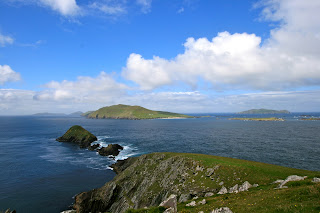Having spent a great couple of days in Kinsale we drove across to Dingle, stopping off enroute for a break in Killarney. With its three famous lakes and great mountain ranges, Killarney in County Kerry Ireland has been the inspiration of poets and painters over many centuries. The Killarney National Park is internationally renowned both for its scenic beauty and scientific interest. Added to the beauty of the three main lakes are many other lakes in the folds of the mountains, numerous picturesque cascades and, rising to the west of the valley, the peaks of MacGillicuddy's Reeks. There are many walks and trails around Killarney ranging from a two hour tourist trail around the town itself to the 215km (135 miles) long distance walking route ("The Kerry Way") from Killarney around the Ring of Kerry. Whilst we were in Killarney we bought a couple of pairs of waterproof trousers fearing the worst from the weather, I'm happy to say we never had the need to wear them.

From Killarney we drove onto the Dingle peninsula (www.dingle-peninsula.ie) and the town of Dingle. If you've enjoyed some of our photos from our first post on Ireland hopefully this will contine as in many ways the scenary around Dingle is quite spectacular, especially the views of the Blasket Islands. The Dingle Peninsula or Corca Dhuibhne (in Irish) stretches 40 miles (48 kilonetres) into the Atlantic Ocean from Ireland's south-west coast. The peninsula is dominated by the range of mountains that form its spine, running from the Slieve Mish range to Mount Brandon, Ireland's second highest peak. The Blasket Islands lie to the west of the peninsuala. Much of the peninsula is a Gaeltacht, an area where the Irish language (Gaeilge) is spoken.
 |
| Just imagine this scene with the sun shining. |
Our home whilst in Dingle was the Dingle Skellig Hotel which you'll find on the left just as you approach the outskirts of the town, their web address is www.dingleskellig.com. Whilst perhaps lacking a little in character, the location is fine, easy to find, a short walk into the town and with some great views from the restaurant where the food is lovely.
 |
| Dingle Skellig Hotel |
As you drive around the peninsula you'll see many examples of Dingle's archaeological past, such as Famine Cottages and BeeHive huts. For more information on the history of the cottage below, check out www.famine-cottage.com.
 |
| Famine Cottage, Slea Head Drive. |
The highlight for us during our stay was our drive round to Dunquin (Dun Chaoin). This parish is at the most westerly tip of the Dingle peninsula, it comprises eleven townlands on the mainlands and the Blasket Islands three miles offshore and is often referred to as "the next parish to America". The area is know for its scenary and the surviving Gaelic culture. The spectacular views of the Blasket islands and the rugged cliffs which make up the coastline are not to be missed, hopefully these photos will convince you about this.
 |
| The beach at Dunquin |
 |
| View of the Blasket Islands |
If you make it down as far as Dunquin, be sure and visit the Blasket Centre (also signposted as Ionad an Bhlascaoid). Within sight of the islands themselves on a headland, this centre was established to highlight the history and culture of the islands. It more than succeeds, even if you've never heard of the Blaskets before, you will leave impressed. You'll also learn about Peig Sayers, an Irish woman who lived both in Dunquin and on the Great Blasket Island after marrying a fisherman who lived there. Her autobiography was for many years (and may still be) on the curriculum for secondary school students in Ireland. She has been described as "one of the greatest woman storytellers of recent times". I'll leave you to form your own opinion either by reading the book, Peig, or by asking for the opinion of some of the people you meet whilst travelling in Ireland.
 |
| The Blasket Centre |
 |
| View from the Blasket Centre |
So finally, what about Dingle town? Mountains at its back, Dingle faces onto a sheltered harbour. About 1,200 people live in Dingle, however it serves the larger population of the surrounding countryside, and in the summer is a busy tourist destination. Fishing and farming have long been the major industries along of course with tourism, especially since the filming of Ryan's Daughter there way back in 1969. It goes without saying that the town is well supplied with Pubs, around 50, from the large modern day pub, to the cozy, to the pub which also acts as a shop selling everything from sheets and blankets to beds and bicycles. As well as the 50+ pubs there are some great shops selling the wares of locally based artists and many restaurants to choose from. We had a great meal in the Chart House Restaurant which is a short walk from the Dingle Skellig Hotel, their website is www.thecharthousedingle.com.
 |
| Dingle Harbour |
 |
| Shop-Bar, ok a little rundown, thats called character. |
This is where our post on Dingle comes to an end with a couple of photos from the town, next stop
County Clare.















Ireland is very nice, beautiful place.......
ReplyDeletemust take a look in
hillwalking in killarney